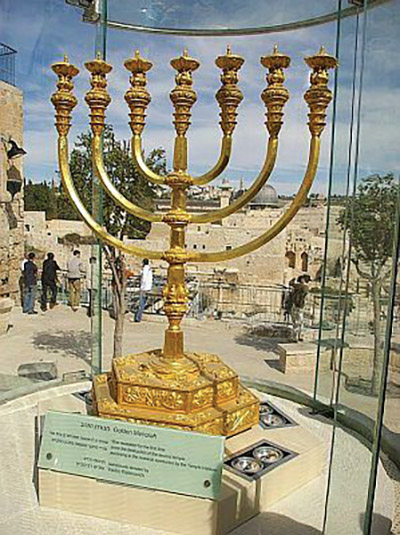As we walk through the Jewish Quarter of Jerusalem to the Western Wall many visitors come across the golden replica of the temple Menorah. The Temple Institute has recreated many of the artifacts and utensils that were once used in the past two temples, the Batei Hamikdash.Our religion and traditions are inextricably tied to the temples and King David’s city of Jerusalem, our historic capitol dating back for thousands of years. It was, therefore, gratifying when the president of the United States recognized the status of Jerusalem and its importance to the Jewish people a few years ago.
Here we are this week celebrating Chanukah, a time when the temple was reclaimed and rededicated. The symbol of the holiday is the menorah. There are several lessons that can be learned by this symbol of our faith.
Rabbi Benjamin Blech asks the question: not knowing there would be a miracle, what made the Jews light the Menorah with so little holy oil? The answer, he suggests, is a lesson in optimism. “No matter how bad the situation, no matter how impossible the probability of success, we begin the task and optimistically have confidence in God to somehow make our efforts prove fruitful.”
Others have pointed out that the biggest miracle of all is that we, as Jews, are still around as a people. It is amazing that we are still bringing the light of Chanukah into our homes after so many attempts to destroy us and our way of life.
Paolo Scheffer, a historian, makes the point that each of us are like the “shamash”(attendant) candle and are responsible to reach out to our fellow Jews. The light of the menorah glows not from individual candles, but from the combined light of the many lights burning together. Similarly, Rabbi Joseph Potasnik comments that, just like the Chanukah menorah, we, the Jewish people, are composed of different branches with common roots. The fact that the branches must be of equal height in order to be kosher, teaches us that we need to respect each other’s differences and see each other as equal partners.
Rabbi Ephraim Buchwald comments that the true battle of Chanukah was not necessarily with the Syrian Greeks but between the traditional Jews and those that favored assimilation, the “misyavnim.” The primary mitzvah of the holiday is to publicize the miracle of Chanukah. While the story of Chanukah took place more than 2,100 years ago, we still battle the forces of assimilation today. That is why we make the second blessing, “… who performed miracles for our ancestors in those days, in these times.” The Gemara (Shabbos 21b) encourages us to light the candles outside the door, not merely in the window. In fact, in Israel, many people do so today, using a glass light box.
Chanukah leaves us with a timely and reassuring message. The forces of light will always prevail. “A little light dispels a lot of darkness.” Freedom will overcome oppression. The forces of brightness and light will always overcome the forces of darkness.
May Hashem bless us so that we are able to celebrate the optimism and brightness that Chanukah represents, not just for eight days but every day in our homes and in our hearts. May the lights of Chanukah shine brightly for us and serve as a source of inspiration for ourselves and for society as a whole.
Rabbi Dr. Avi Kuperberg is a forensic, clinical psychologist in private practice. He is president of the Chai Riders Motorcycle Club of NY/NJ. He leads the Summit Avenue Shabbos Gemara shiur and minyan in Fair Lawn, NJ and is a member of the International Rabbinical Society. He can be reached at [email protected].










